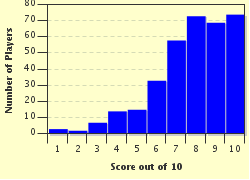Quiz Answer Key and Fun Facts
1. The joint in the human skeletal system that has the greatest range of motion can be found in the shoulder. What kind of joint is the shoulder?
2. The least complex type of joint allows one-directional movement in our elbows, our fingers and toes, and (in a modified form) in our knees. What is this simple type of joint called?
3. What type of unique, complex joint allows the thumb to cross over the palm of the hand, permitting a kind of movement that gives human hands great flexibility, allows us to grip an object, and makes fine coordination possible?
4. Some joints are "fibrous joints" or "fixed joints" that allow very little movement. Where in the adult human body would we find around twenty fixed joints called "sutures"?
5. The only bone in the human body that does not form a joint with any other bone is a small, "floating bone" that is shaped like a U. It helps us breathe, swallow, and move our tongues. What is the name of this bone?
6. Strong fibers, considered part of the skeletal system, hold joints together, attaching bone to bone like elastic bands and preventing dislocation and uncontrolled movement of the joints. What are these fibers called?
7. The upper end of the femur fits into the acetabulum of the pelvis to form an important joint in the human body called the acetabulofemoral joint. What type of joint is this, and where in the human body is it found?
8. Sometimes called "the shock absorber of the body" what pearly white, slippery connective tissue at the epiphysis of a long bone in the human body provides a smooth surface that reduces friction so that the joint can move properly without being damaged?
9. Fixed and semi-fixed joints do not need cushioning, because they either do not move or they move very little. Moveable joints, however, have cartilage and capsules of fluid that keep hard bone surfaces from rubbing together and causing damage. What do we call the fluid that protects moveable joints?
10. The pivot joint between the atlas and axis bones (also called the atloaxoid joint) can also be called a "gliding joint" because it allows smooth movement from side to side, so that a certain part of the body can swivel and bend. What part of the body does this joint allow us to move?
Source: Author
nannywoo
This quiz was reviewed by FunTrivia editor
CellarDoor before going online.
Any errors found in FunTrivia content are routinely corrected through our feedback system.

